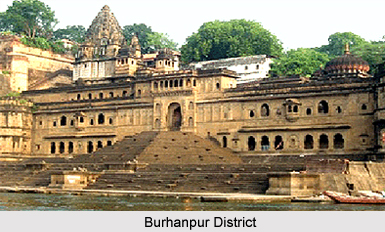 Burhanpur District is a district of the state of Madhya Pradesh in the central part of the Indian subcontinent. The town of Burhanpur is the district headquarters. The Burhanpur District came into being on August 15, 2003, from the southern portion of the Khandwa (East Nimar) District.
Burhanpur District is a district of the state of Madhya Pradesh in the central part of the Indian subcontinent. The town of Burhanpur is the district headquarters. The Burhanpur District came into being on August 15, 2003, from the southern portion of the Khandwa (East Nimar) District.
History of Burhanpur District
History of the Burhanpur District goes thus. In 1536 A.D., one of the Mughal Emperors of India, Humayun, after his conquest of Gujarat, came to Burhanpur District and Asirgarh via Baroda, Broach (Bharuch) and Surat. At that time Raja Ali Khan, was asked to surrender to Akbar, when the latter had sent an expedition to Khandesh, in the summer of 1577 A.D. Raja Ali Khan gave away his royal title of Shah and accepted the dominion of Akbar. This marked an age in the Deccan policy of the Mughals, for Khandesh was used as a foundation for the future Conquest of Deccan. Raja Ali Khan constructed many buildings like Jama Masjid in the upper portion of the fort of Asir in 1588 A.D. However, Bahadur Khan (1596-1600 A.D.) successor of Raja Ali Khan affirmed his independence and declined to pay homage to Akbar and his son Prince Daniyal, which enraged Akbar, who marched towards the Burhanpur District in 1599 and occupied the city of Burhunpur without any opposition on 8th April 1600 A.D.
Later, Prince Khurram was designated as the Governor of the Deccan in 1617 AD, by Jahangir to succeed Prince Parviz, and was bestowed the title of Shah by Jahangir. After the death of Jahangir in 1627, Shah Jahan ascended the throne of Mughal Dynasty. Due to atrocities in the Deccan, he reached the present day Burhanpur District on 1st March 1630, where he stayed for the next two years, conducting operations against Bijapur, Ahmadnagar District, and Golconda. On 6th March 1632, Shah Jahan left Burhanpur for the north, after assigning Mahabat Khan as the Viceroy of the Deccan.
During the reign of the British East India Company, it can be found that the Burhanpur district was affected by the Sepoy Mutiny 1857 against the British rule, which also spread over the rest of the country. The district was also greatly affected by the Non-Co-operation movement, the Civil Disobedience movement, the Quit India Movement and the like from the close of the 18th century until 15th August 1947.
Geography of Burhanpur District
The Tapti River flows through the district from east to west. The Satpura Mountain Range divides the district into the Khandwa District on the north, which is also the demarcating line between the Narmada River valley and the valley of the Tapti. There is a pass through the Satpuras that links Burhanpur and Khandwa. This pass is one of the main routes linking northern and southern India. The pass has the Asirgarh fortress, which is also known as the "Key to the Deccan".






